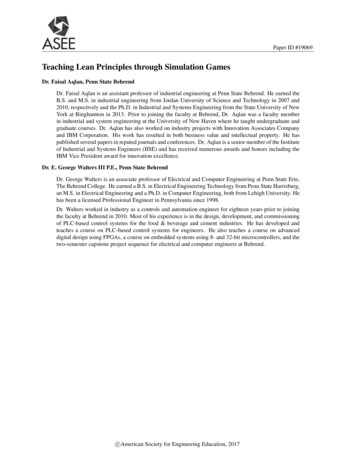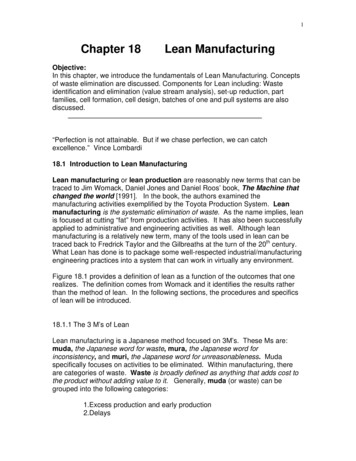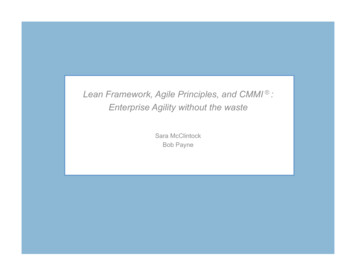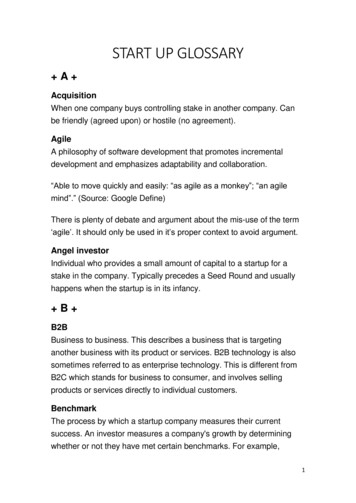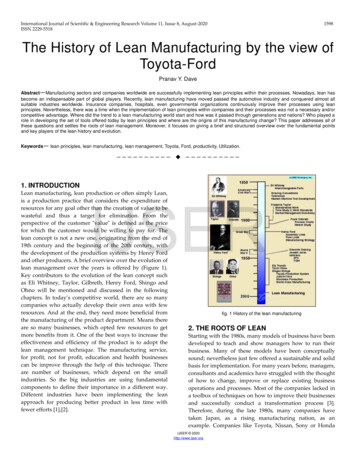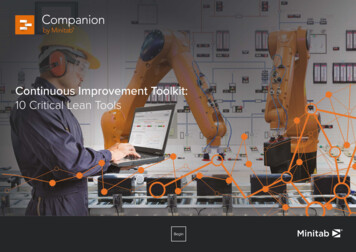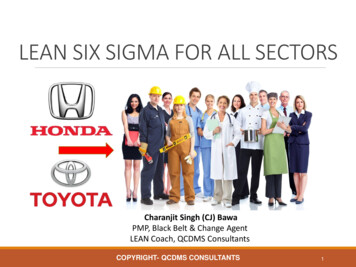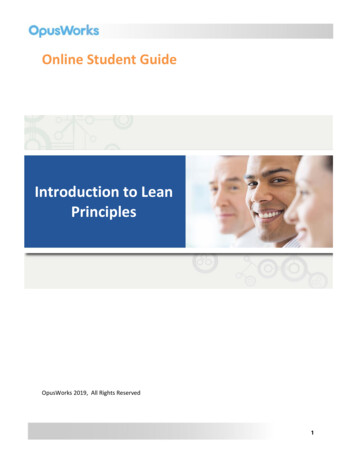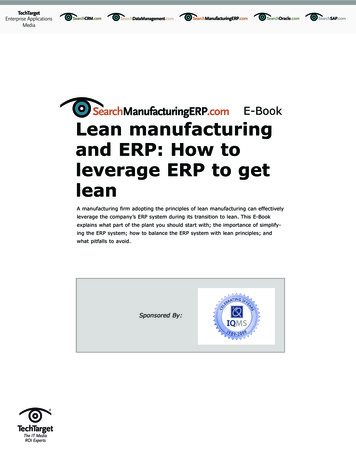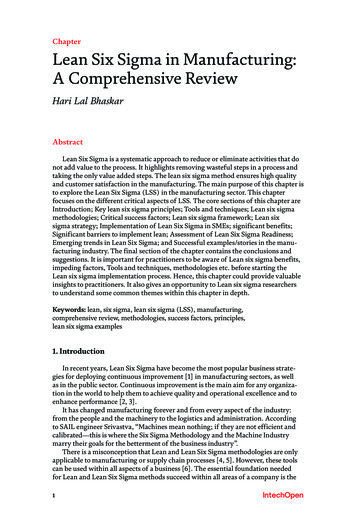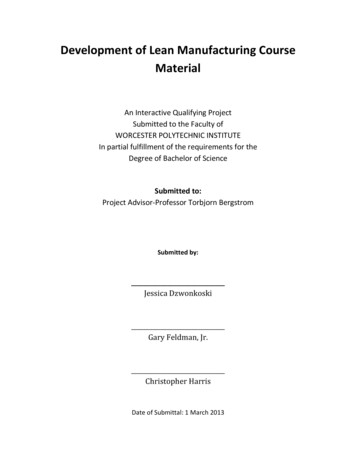
Transcription
Development of Lean Manufacturing CourseMaterialAn Interactive Qualifying ProjectSubmitted to the Faculty ofWORCESTER POLYTECHNIC INSTITUTEIn partial fulfillment of the requirements for theDegree of Bachelor of ScienceSubmitted to:Project Advisor-Professor Torbjorn BergstromSubmitted by:Jessica DzwonkoskiGary Feldman, Jr.Christopher HarrisDate of Submittal: 1 March 2013
Development of Lean Manufacturing Course MaterialAbstractOur goal was to develop lean manufacturing course material for high school students inmachine tool technology programs. In addition to developing a potential curriculum, weresearched different lean manufacturing principles and decided that a module on 5S VisualManagement would be best suited for the first teaching module. We were able to test themodule and gather the necessary feedback required to improve it.2
Development of Lean Manufacturing Course MaterialTable of ContentsAbstract . 2Table of Contents . 3List of Figures . 4Introduction . 5Objective . 5State of the Art . 5Rationale . 6Introduction to Lean Manufacturing. 6Approach . 15Methods . 15Project Organization. 15Survey Creation and Implementation . 15Lean Manufacturing Research . 175S Teaching Module Creation . 175S Teaching Module Testing . 19Results . 19Survey . 19Chicopee Comprehensive High School Feedback . 19Local Manufacturing Firm Feedback . 20College-Level Manufacturing Class Feedback . 20Discussion. 20Logistical Issues with Survey . 205S Teaching Module Development . 215S Module Proctor Copy Development . 215S Teaching Module Testing and Feedback . 215S Teaching Module Revision. 22Project Continuation . 22Conclusions . 23Appendix . 24IRB Information . 24Survey Drafts . 285S Teaching Module and Proctor Copy . 30Sample Presentation from Local Manufacturing Firm . 56Works Cited . 623
Development of Lean Manufacturing Course MaterialList of FiguresFigure 1- Lean Manufacturing Principles . 7Figure 2- Basic Value Stream Mapping Flow Chart . 7Figure 3- Continuous Flow Production . 9Figure 4-Cellular Layout . 9Figure 5- Flow Chart of 5S . 13Figure 6- Implementation process of 5S . 14Figure 7-IRB Approval Form . 24Figure 8-IRB Application Form, page 1 . 25Figure 9-IRB Application Form, page 2 . 26Figure 10-IRB Application Form, page 3 . 27Figure 11-Survey Rough Draft . 28Figure 12-Final Survey . 294
Development of Lean Manufacturing Course MaterialIntroductionObjectiveCreate training material available on the internet in order to enhance the educationalexperience for high school students in a machine tool technology program at no cost to theindividual schools.State of the ArtA simple Google search will yield numerous results for online lean manufacturing courses.Most of these sites have a variety of modules including 5S Visual Management. Each websitegives a brief description of the content in the modules and other material that is available witha subscription. Most of the websites require the purchase of a subscription to the site whichranges from 3 months to 1 year and they vary in price.For example, the development of lean course material has been visited by a company calledLean Marketplace.1 This company offers a program which includes various modules on leanprinciples such as 5S, Lean Management, Lean Maintenance, and others.This program alsooffers presentations and resource assistance for developing course curriculums and studentprojects. A subscription to the Lean Marketplace costs 69.99 every three months.Productivity Innovation2 is also another website that offers various teaching modules. This siteoffers 5S visual management for 279.00 for a one month subscription.The 5S VisualManagement program consists of seven separate modules: Introduction, Sort, Set, Shine,Standardize, Sustain, and an implementation module. This site also offers a variety of exercises,handouts, worksheets and www.productivityinc.com/products/programs.shtml5
Development of Lean Manufacturing Course MaterialThe purpose of this IQP is to develop material that can be used to help teach high schoolmachine tool technology students. The material will be interactive with various forms ofmultimedia, questions and answers, and activities for students to do. The material developedin this IQP differs from other companies’ products because it is free to use and access, therebyalleviating the high cost of similar material for schools that may already have a tight budget.RationaleIn the competitive job market, many technical high school graduates find it difficult to findemployment. As such, it is imperative that they have the necessary skills that are on par with orexceed the industry standards. Companies are now starting to heavily rely on leanmanufacturing principles, and unfortunately some current curriculums at the technical highschool level do not incorporate or have overlooked these principles. By sending out a survey tomanufacturing teachers at vocational high schools, we hoped to learn what principles theteachers want to teach and what principles might be missing from the current curriculums.However, we were unable to collect data from this survey due to logistical complications.Therefore we decided to create presentation material on 5S because it is a fundamentaltechnique for lean manufacturing.Introduction to Lean ManufacturingThe objective of a lean approach to manufacturing is to maximize the value of the product tothe customer while minimizing waste. Many companies in the manufacturing industry use leanmanufacturing principles (LMP) to maximize their profit, minimize their cost of production, andeliminate waste.Lean principles can be applied to nearly anything from optimizingmanagement to developing vertical and horizontal integration that help with optimizing theflow of products.Figure 1 shows several tools which can be used to promote leanmanufacturing.6
Development of Lean Manufacturing Course MaterialFigure 1- Lean Manufacturing Principles3Value Stream Mapping: A flow chart that incorporates symbols and pictures to depict the flow ofmaterial and other information. Value Stream Mapping is used to provide the customer withmaximum satisfaction along with creating a process with minimal waste in design, assembly, andsustainability. (George, 2002, pp. 51-55)Figure 2- Basic Value Stream Mapping Flow ng.html7
Development of Lean Manufacturing Course MaterialStandard Work: By creating a process that is standardized, a baseline process is created enabling forcontinuous improvement to occur for that particular process. Standardizing work usually consists ofthree basic principles: Takt time, a precise work sequence which tasks are performed inside of thetakt time window, and a standard inventory which could include machines or products. Standardwork is the basis for many of the lean principles used today.Poka-Yoke: This Japanese term refers to mistake proofing devices. These devices are often built intoor interlocked with machinery or fixtures to prevent missing an operation or loading the part wrong.(Fisher, 1999)Point of Use Storage: This is a process where materials are stored in a particular work area wherethey are used and easily accessible. This allows for the simplification of physical inventory tracking,storage, and handling. The point of use storage method is best utilized when suppliers deliver smallshipments frequently and timely.5S Visual Management: Visual management allows for the production floor to be analyzed quicklyand easily. 5S incorporates five stages to reduce distractions, clutter, and potentially hazardoussituations: Sort which gets rid of trash and clutter, Set which is to ensure that every tool has its ownplace, Shine which ensures that the workplace is clean and well maintained, Standardize whichmakes the production process consistent, and finally Sustain which allows for the process that wasrefined by the four previous stages to remain in working condition. (Monden, 1993, pp. 199-219)One-Piece Flow Production: One-piece flow production, also known as continuous flow production,is a manufacturing technique where parts move from one operation smoothly to the next without await or Work-in-Progress (WIP) in between steps. In the past, many companies would manufacturea batch of parts with the entire batch moving one step at a time. This method tends to create abottleneck where excess parts build up at a slower step. Using batches can also cost a companysignificantly more money when a defect is found because an entire batch of product can be ruined.Continuous flow allows parts to arrive at the next step just as they are needed. This method resultsin a more efficient use of machine time and floor space. (Hobbs, 2004, pp. 8
Development of Lean Manufacturing Course MaterialFigure 3- Continuous Flow Production5Continuous flow production works best in a cellular layout where the different machines for eachstep are close to each other. This design allows parts to move quickly from step to step.Figure 4-Cellular Layout6One-Piece flow does not always work. Some cases when this method will be inefficient are: If a particular process has a high probability of creating a defective part, the next step willnot receive a part and machine time will be wasted.If process times are not consistent, you cannot design a continuous flow system becauseyou never know when a part will be ready to move to the next stepIf machine equipment has low reliability.If processes cannot be scaled to take approximately the same amount of time as the d/14703/one-piece-flow9
Development of Lean Manufacturing Course MaterialTPM Equipment Reliability: Total Productive Maintenance Equipment reliability deals withensuring that machines are running as much as possible. While half of all downtime is due toemployee breaks and regular maintenance, the other half is due to unscheduled downtime likemalfunctions, breakdowns, material shortages, or employee error. This half of downtime is whatTPM eliminates. (George, 2002, pp. 214-217)Level Mix Model Production: Level mix model production analyzes areas of production with excessparts and areas with a shortage of parts with the intent of providing supply equal to demand. Thissystem eliminates space wasted with a stockpile and time wasted waiting for products to arrive. Italso helps a company better match customer demand quickly by allowing for smaller batch sizesthat allow production to flow more smoothly. (Monden, 1993, 24)Kanban: Kanban is a system that utilizes signs and signals to determine when to replenish supplies.It simplifies how inventory is tracked and managed by alerting staff when they need to ordermaterials. This allows companies to better match production with demand. The goal of Kanban isto maintain a rapid manufacturing pace while lowering the cost of maintaining inventory. (Monden,1993, pp. 15-35)SMED Quick Changeover: Single Minute Exchange of Dies, or Quick Changeover, is a system createdto keep a product moving through various production steps by keeping the time between steps to asingle-digit minute (0-9min).FMEA: Failure Mode Effects Analysis is a process that identifies potential places of failure in amanufacturing process. The possible failures are then ranked by the severity of their consequences,the potential failure frequency, and the failure’s ease of detection. FMEA also keeps track of pastfailures in an effort to continually improve production. In order to be effective, FMEA must beinvolved in all steps of designing a production process. (George, 2002, pp. 190-191)Eliminating waste is a major part of creating and developing a lean process. A major part ofdeveloping a lean process is eliminating waste, the most obvious of which is material wastecreated by inefficient machining processes. Other types of waste addressed by lean processesare stockpiling of incomplete parts in an inefficient process and wages of workers who do jobs10
Development of Lean Manufacturing Course Materialthat could be automated. The most important waste addressed is perhaps waste created byerrors in machining. This particular waste is multi-faceted because it not only involves remaking faulty parts, but also the fact that companies have to inspect parts in the first place tosee if they are good. Processes that are lean will eliminate as much waste as possible all alongthe path from raw material to finished part. If waste is eliminated along the entire valuestream rather than focusing on isolated points, it creates processes that do not need constantattention from employees which in turn maximizes space efficiency and productivity.While the manufacturing industry tends to be most associated with lean principles, otherindustries can benefit as well. For instance, businesses and government can streamline theirprocesses and increase efficiency by applying lean principles. These companies may or may notrefer to their new principles as “lean,” but they still have the same end goal of reducing costand increasing efficiency. This paradigm shift towards lean principles shows that a company iseliminating outdated and inefficient processes in favor of newer, more efficient methods.OriginMany people believe that the principals involved in lean manufacturing originated with theToyota Motor Corporation. However, Henry Ford really started implementing lean principleslike standardization of parts, waste reduction, and limiting downtime between production stepsin the early 1900s. Ford’s assembly line revolutionized the production of automobiles from aseries of complicated steps that required a high level of knowledge to a longer series of simplersteps that could be completed by lesser-trained employees. The assembly line also brought thepart to the builder rather than the other way around. In his book, My Life and Work, Ford shedlight on the concept of waste by discussing how companies often have an inefficient layout fortheir machines and how people will habitually do something even though it is inefficient.Kaizen is the modern equivalent of how Ford rearranging the workplace for increasedefficiency. Ford also pioneered the concept of standardization where a part from one vehiclewill fit in the same space on an identical vehicle. Before standardization, every part was customfit to each automobile which slowed the manufacture of each car and made them more difficult11
Development of Lean Manufacturing Course Materialto repair. Ford also explored waste reduction in other areas of manufacturing like ensuring thatall the iron from the furnaces was used to create cars and none was left behind. (Ford, 2008)Toyota Motor Corporation took over where Henry Ford left off with the Toyota ProductionSystem (TPS). TPS focused on increasing profits while cutting costs by eliminating waste. Someprinciples pioneered in the TPS are: The concept that production should adapt to market changes. Just-in-Time (JIT) manufacturing wherein parts are machined so they arrive at the nextstep exactly when they are needed. This prevents excessive stockpiling. The Kanban System which is used to ensure that material and products flow smoothlythrough a facility. This helps to reduce lead time and allows for smaller lot sizes. A standard operations routine which aims to make each production step take thesame amount of cycle time.With TPS, Toyota was able to improve their manufacturing process by increasing efficiency,reducing defects and waste, and increasing worker morale. (Monden, 1993, pp. 114)Introduction to 5S5S is a one of the most fundamental parts of Lean Manufacturing.It is also relativelystraightforward to teach. This section discusses 5S in greater detail because it is the topic ofour project’s first module.5S is a system used to help make production more efficient and cost-effective. The systeminvolves 5 individual processes, or pillars. These pillars focus mainly on eliminating waste andcreating a more organized workplace.Many companies use 5S as a primary means ofimproving efficiency. 5S is also one of the simplest ways to improve a manufacturing processbecause it forces the workspaces to be clean, organized, and free of clutter.12
Development of Lean Manufacturing Course MaterialFigure 5- Flow Chart of 5S771.Sort (Seiri). It looks at an existing workplace and analyzes what tools, equipment, andmaterial are required for a given production task. Anything that is not necessary is removedfrom the workspace. The primary benefit of sorting is a reduction in the required floorspace for that production task.The Sort step in 5S also increases productivity byeliminating potential distractions like clutter.2.Set in Order (Seiton). This pillar creates an efficient equipment layout so that workers caneasily find tools and material needed for the process. This pillar also requires that the firstpillar has already been completed and the area is free of unnecessary items. A popular toolfor this pillar is the use of a shadow board to organize tools.3.Shine (Seiso). It involves cleaning the workplace and keeping it clean. Once the area hasbeen organized, it needs to be thoroughly cleaned and repaired. Then, everyday cleaning isrequired to maintain a high level of cleanliness and organization. The step Shine raisesmoral of workers because they are responsible for the cleanliness of their workspace and itis easier to work and be proud of the work they produce.4.Standardize (Seiketsu). This pillar involves creating a consistent way to do every task so thatthey are done the same way every time. It also involves assigning people to maintain thefirst three S’s. Some tools of standardizing are checklists, charts, and short meetings toensure that jobs are being completed correctly.http://www.squidoo.com/lean5S?utm source google&utm medium imgres&utm campaign framebuster13
Development of Lean Manufacturing Course Material5.Sustain (Shitsuke). It ensures that 5S practices are carried out all day, every day. This pillaris also critical in helping to change workers’ mentality so they follow 5S practices in theirdaily routine.The implementation of 5s is important to the manufacturing workplace because it enables thecompany to analyze their existing process and discuss ways to improve the process.Figure 6- Implementation process of 5S8It is imperative that the 5S’s be maintained because if they are not, then the infrastructure ofthe process will fail and potentially cost the company money. One benefit of implementing 5Sis that it reduces waste which in turn improves the efficiency of the process. Another benefit of5S is it reduces the space that is required for storage is reduces. 5S also improves maintenanceof the equipment and the appearance of the manufacturing floor, improves safety by removingclutter and items that are astray, and it also improves quality of the product along with thequality of work done by the employees. (Monden, 1993, pp. 199-219),(Hobbs, 2004, pp. 5s/practical-approach-successful-practice-5s/14
Development of Lean Manufacturing Course MaterialApproachOur approach to the project was as follows:1. Design and Implement a survey to gauge high school teacher interest in certaintopics2. Research Lean Manufacturing Principles to determine what information couldfeasibly be included in teaching modules3. Determine which media format to use for the module4. Create the 5S Teaching Module5. Test the 5S module6. Edit the 5S Module to reflect feedbackMethodsProject OrganizationThe majority of this project was organized with a SharePoint account which allowed the projectmembers and advisor to upload and edit documents and assign tasks while maintaining anadequate timeline.Survey Creation and ImplementationThe next step of the project was creating an effective survey. The purpose of the survey was toadequately gather information about our research topic. After the first draft was created, itwas clear that it needed some editing. We researched how to create effective surveys usingdifferent educational resources from Keene State and Colorado State Universities.We wereable to use these sources to create a successful survey that was easy to follow. For example,the general consensus from all three sources was to order the questions in such a fashion so asto avoid biased opinions by putting sensitive questions at the end of the survey. Another keypiece of information we took from the documents was not to make the survey too long becauseif there are too many questions in the survey, the participants would be less likely to finish it.15
Development of Lean Manufacturing Course MaterialIn order to improve the rough draft of the survey, we removed the first question because itinvolved potentially sensitive material that was not relevant to the scope of our project. Thenwe to provided survey participants with more detailed answers to our survey questions so wecould gather more detailed information than “yes or no” questions could provide. We alsowanted to determine why certain principles were covered in the classroom while other topicswere neglected, along with what topics the teachers would prefer to have material for. Thiswould allow us to develop the teaching modules in accordance with what teachers want orneed.Another piece of information we asked for was what teaching medium (PowerPoint,videos, pictures, etc.) teachers preferred and whether or not they would use such a resource.Our last change was to give participants the option to us by using a Worcester PolytechnicInstitute mailing list called lean@wpi.edu. Both the rough and final drafts of the survey can befound in the appendix section of this paper.When the survey was edited and reviewed by Professor Bergstrom, we sent the survey and itsintent to the Institutional Review Board (IRB). The purpose of the IRB review process is to makesure that our questions do not endanger survey participants by asking personal or privateinformation. The forms required to submit a survey to the IRB are found in the appendix.These forms are available on the WPI website (www.wpi.edu) in the Offices and Servicessection. After the survey was sent to the IRB (irb@wpi.edu) a reply was sent to all of theauthenticated users on the project, stating that the survey was approved and we were free tosend the survey out to the participants which can also be found in the appendix section.After the review process from the IRB was completed successfully, the survey was sent out tohigh school machine tool technology teachers along with a paragraph about what it is we aretrying to accomplish. However, the survey was not as successful as hoped and only received afew views due to logistical complications. Therefore, we decided to come up with a backupplan. After discussing options with Professor Bergstrom, we decided that a teaching modulecovering 5S would be a good place to start because most industries use 5S principles.16
Development of Lean Manufacturing Course MaterialLean Manufacturing ResearchWe researched Lean Manufacturing Principles to gain the necessary level of knowledge tocreate the Introduction to Lean Manufacturing Section of this paper.We then furtherresearched 5S principles in order to create the 5S Teaching Module.5S Teaching Module CreationWe then needed to determine what form of media would most effectively convey ourmessage to the students. We were considering using a teaching tool called ASSISTments tocreate an online course. Based on personal experience with high school technology students,we decided not to use ASSISTments because it was not interactive enough and some schoolsmight not have the necessary number of computers to facilitate such a product. As such, wedetermined that using a PowerPoint presentation in combination with interactive classroomactivities would be the best way to teach a class because it allows for a single teacher topresent to an entire class and the material will keep students’ attention.We created an outline and a basic template for the module in the form of a PowerPointpresentation. This presentation gives a brief overview of 5S and then details each 5S pillar. Wealso included a short video for each section. After each video, we show picture examples ofhow each pillar can be used. Then we ask 2-3 short questions for each pillar. These questionsprovide a comprehensive review of the important points for each pillar. The module isdesigned to give a basic understanding of 5S principles upon which students can build duringtheir careers. This way, students will at least be familiar with 5S when they apply for a job afterhigh schoolIn addition to the teaching module outline, we also included a teacher copy of the outlinewhich includes some additional information and the answers. The proctor copy also detailshow an instructor should go about teaching the module. For example, we suggest tha
technique for lean manufacturing. Introduction to Lean Manufacturing The objective of a lean approach to manufacturing is to maximize the value of the product to the customer while minimizing waste. Many companies in the manufacturing industry use lean manufacturing principles (LMP) to maxi
